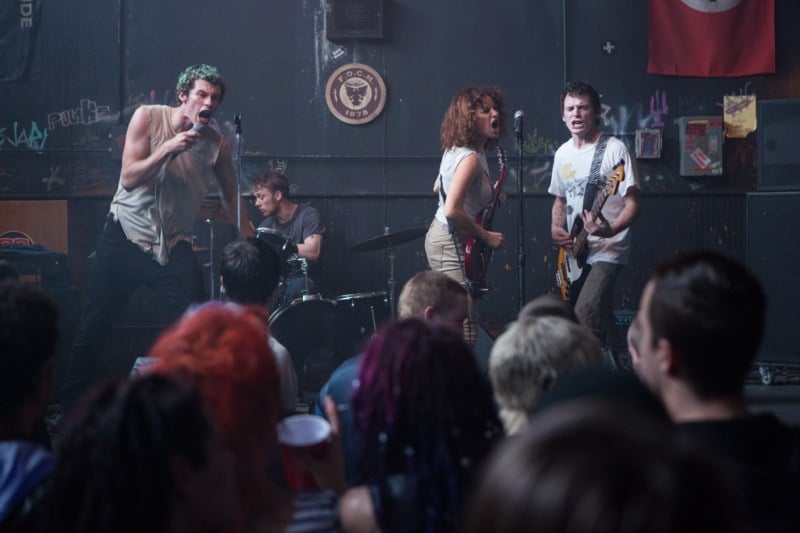In 2013, writer-director Jeremy Saulnier became an overnight indie sensation with “Blue Ruin,” the enthralling story of an average man seeking vengeance against the family that killed his father. Coming six years after Saulnier tried to establish himself with the little seen horror-comedy “Murder Party,” “Blue Ruin” was an all-or-nothing gamble for the then-unknown director which paid off handsomely – reaping much praise, if not profits.
Now, three years later, Saulnier has finished directing his first theatrical film, the fiendishly clever thriller “Green Room.” The story of a punk-rock band who accepts a last-minute gig playing for a bunch of neo-Nazis, “Green Room” was inspired by Saulnier’s own experiences as a member of Virginia’s punk scene in his youth.
The Stanford Daily recently sat down with both him and “Green Room” star Anton Yelchin (“Star Trek,” “The Smurfs”) to discuss their experiences making the film.
The Stanford Daily (TSD): Your first film “Murder Party” was also primarily shot in one location. How did you approach this film differently and what have you learned in the decade since you made “Murder Party”?
Jeremy Saulnier (JS): Well, after “Murder Party,” I swore I would never do it again. So, I’m an idiot. Cinematically I found [“Murder Party”] lacking. I didn’t quite have my shit together. I was using lot of steadicam. I had a great steadicam operator, and I kind of let him loose. But I didn’t feel the film was fully realized visually.
I think “Green Room” is much more visually precise and better realized than “Murder Party,” because I wasn’t afraid. When we had to lock a camera and just get a shot of an actor saying something, the impact of his performance is what was really driving the story. Not so much how much I move the camera. That being said, Sean Porter (the cinematographer of “Green Room”) and I, we were able to do traditional filmmaking, in that I am used to having the storyboard in advance.
TSD: On the note of directors of photography: You were DP for all of your previous films. What was it like passing the torch?
JS: Based on the necessity of this production, it was easy and kind of inevitable. “Blue Ruin” was very much a quiet film. There were only about three major dialogue scenes. “Green Room” had the ensemble cast, all those stunts, the bloodwork, the special effects — so I knew from the beginning that I wasn’t even going to try and shoot this by myself. Because if I was focused on looking through the eyepiece, I would be neglecting too many things.
So Sean Porter was brought on because he has a diversity of styles. He doesn’t try to put his imprint on a director’s film. He tries to really translate what they’re thinking. I saw some the independent films he shot beforehand, mostly “It Felt Like Love” and “Kumiko, the Treasure Hunter.” Those are very different films, and I’d never think they were shot by the same person. For that reason, I knew he could translate. He could watch “Blue Ruin,” we could have a very enriching conversation, and then I would let him go. And he would really translate the visuals, as I would have, but only he could. It was awesome.
I do a lot of things out of necessity. I write, I shoot, I direct. I can edit, too, if I have to. But this is because of being crushed by the indie world, where you have to wear so many hats. If I could eventually just direct, it would be a dream.
TSD: Your movies, both “Blue Ruin” and this one, have really phenomenal and really grounded performances. So I am curious if you have a technique for working on actors, and what it is?
JS: Yeah, what is my technique?
Anton Yelchin (AY): I still have no idea, dude.
JS: No, seriously, do I have a technique? I don’t perceive myself as having a technique, I just cast them.
AY: Well, I think if you watch Jeremy’s movies, they have a true sensitivity to performance. And I think that’s exactly what it’s like on set. I know that Jeremy is going through a lot of stuff that we had no idea about. And that is your approach. We had no idea of all the things Jeremy was dealing with, beyond just trying to man the ship.
I am sure there are directors that don’t care about actors or don’t know even how to be sensitive to actors. And I felt that sensitivity, and I think it comes through on the screen. This is a movie where we are all really vulnerable. So I am grateful to you, Jeremy.
JS: As far as keeping it grounded, it really is about casting. We just went for real people. And I knew that a whole lot of weight would be on their shoulders. Sure, this is a straight-up genre film, but it’s human. It’s supposed to be a whole lot more than that. And if we didn’t have genuine, high-class performances, then this would be a strictly video-on-demand title. It would be an embarrassing, half-realized version of what it is now. My approach to casting was getting people with a certain amount of humanity and investment in their characters. And as I direct, I have to create this environment of mutual respect. And, along with that, acknowledging the vulnerabilities of me with them, and them with me. We are putting ourselves into each other’s hands.
And I would say directorially, my skill set is letting them know the story beats being hit. I don’t know the language of performance and inflection, but I know I can guide them through every little nuanced story beat. So narrative-wise, I feel very comfortable. But I am definitely trusting them with so much as far as the actual performance.
Contact Raymond Maspons at raymondm ‘at’ stanford.edu.
